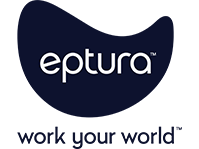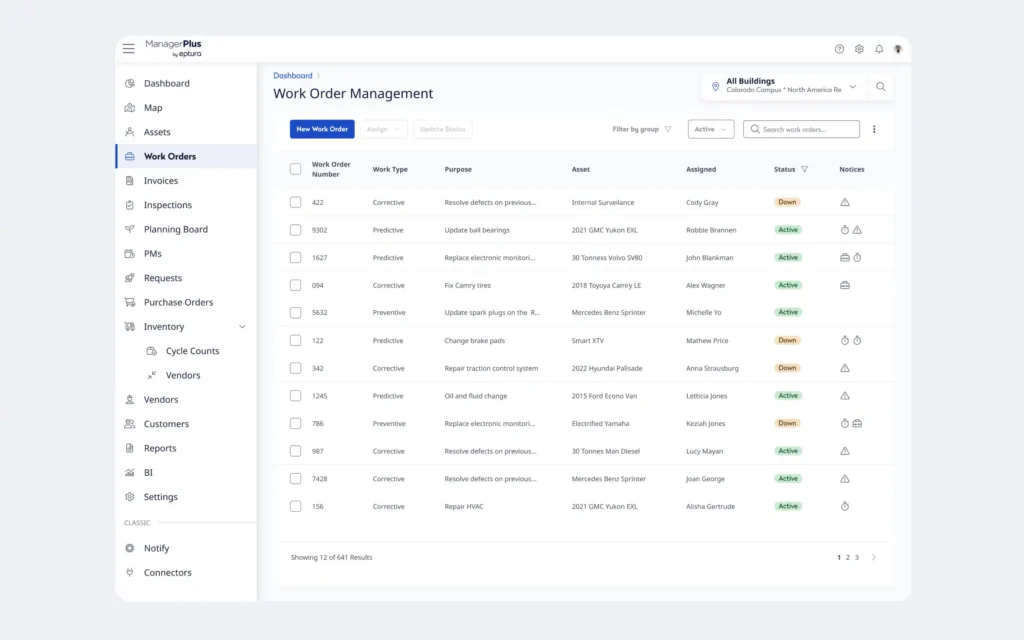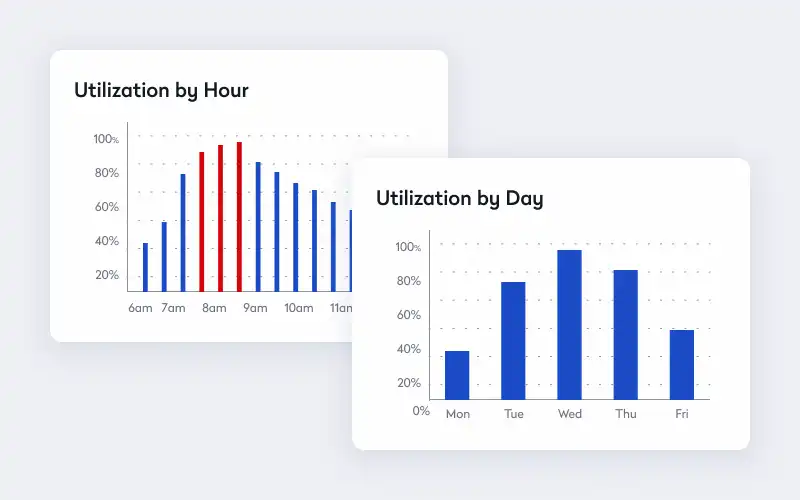
Trying to work with data silos across digital solutions remains an issue for facility and maintenance managers. 58% of surveyed enterprises report multiple dashboards as the largest challenge to analyzing organizational data, according to Eptura’s 2025 Workplace Index report. At 55%, the second most common answer is the length of time it takes to accumulate meaningful data across solutions, while 32% pointed to the cost of analyzing data across solutions.
One of the many benefits of a unified platform is the ability to leverage dashboards to help managers see the big picture, empowering them to respond faster, better manage resources, and find and scale efficiencies across the enterprise.
Challenges of visually distributed, disorganized data
When workplace and facility leaders struggle to see all their data in one spot, the most common issues can include:
- Delayed responses: Identifying and addressing maintenance issues take more time when the manager must manually check multiple systems or reports, leading to longer downtimes and increased costs.
- Misallocate resources: Without a clear overview, the department misallocates resources like personnel, tools, and materials, leading to wasted time and money.
- Poor compliance and auditing: Compliance with regulatory standards and internal policies becomes more difficult when data is scattered across different systems, creating non-compliance issues and potential legal or financial penalties.
- Inaccurate reporting: Generating accurate reports for stakeholders becomes difficult when data is fragmented, affecting transparency and trust with leadership, customers, and regulatory bodies.
- Missed opportunities for optimization: Without a holistic view, it’s much harder for managers to identify patterns and trends that could lead to process improvements and cost savings.
- Weaker communication: Inconsistent or incomplete data can lead to communication gaps between different teams, such as maintenance, operations, and management, resulting in misunderstandings and inefficiencies.
- Higher operational costs: Inefficiencies and delays can lead to higher operational costs, including increased labor, material, and energy expenses.
All these issues create problems for facility operations and maintenance teams, and taken together, they make proactive strategic thinking impossible.
Ineffective decision-making
Without a comprehensive view of all data, managers may make decisions based on incomplete or outdated information, leading to poor outcomes. For example, in a large enterprise with multiple locations and many buildings, a facility manager might need to decide on the best time to schedule maintenance for a critical piece of machinery. If the manager relies on fragmented data from various systems, they might miss important details, such as the machine’s recent performance issues or the current production schedule. As a result, they could schedule maintenance during a high-production period, causing unnecessary downtime and financial losses. In an office setting, they might have the maintenance teams working at a time when the occupancy rate tends to be higher, creating extra challenges for the team and unnecessary interruptions and distractions for other employees.
Another example is when a manager needs to allocate resources for a new maintenance project. Without a unified dashboard, they might not have a clear understanding of the availability of personnel, tools, and materials across different locations. Unclear about how best to deploy resources, they over-allocate in one area and under-allocate in another, causing delays and increased costs.
In all cases, by the time the manager has compiled all the information they need to understand a situation, the data might already be outdated, making it less useful for decision-making.
Reduced productivity
Time spent switching between different systems and tools to gather necessary information can reduce productivity and efficiency. For example, in a large enterprise with multiple locations and many buildings, a facility manager might need to compile a report on the status of all HVAC systems. Without a unified dashboard, they would have to log into various maintenance management systems, review different spreadsheets, and check multiple email threads to gather the required data. The process can take hours, during which the manager is unable to focus on other critical tasks, such as addressing other maintenance issues or planning long-term strategies.
Another example is when a manager needs to assess the overall performance of their maintenance teams. If they must switch between different systems to gather data on work orders, completion times, and employee availability, the process quickly becomes both cumbersome and time-consuming. For example, a manager might spend an entire morning pulling data from the work order management system, the time and attendance software, and the project management tool to evaluate team performance. The extensive time investment not only reduces the manager’s productivity but also delays the ability to make timely adjustments and improvements to team operations.
How dashboards help large enterprises with multiple locations
Large organizations can curate dashboards in a unified platform to take full advantage of the data they create and capture across their real estate portfolios.
Faster response times
With a unified dashboard, identifying and addressing issues becomes much more efficient. For example, in a large enterprise with multiple locations and many buildings, a facility manager can instantly see real-time alerts and notifications from all connected systems. If a critical piece of equipment in one of the buildings starts to malfunction, the manager can see it right away on the dashboard, allowing them to dispatch the appropriate maintenance team. A proactive approach minimizes downtime and reduces the risk of costly repairs, ensuring that operations run smoothly across all locations.
Efficient resource allocation
A unified dashboard provides a clear and comprehensive overview of all resources, enabling the facility manager to allocate personnel, tools, and materials more effectively. In a large enterprise, this means that the manager can quickly see which teams are available, what tools are on hand, and where parts and materials are located. For example, if a maintenance project is scheduled at one location, the manager can easily reallocate resources from another location where they are not currently needed. The entire organization — not just a single location — can use resources optimally, reducing waste and lowering operational costs.
Comprehensive compliance and auditing
In a large enterprise, a facility manager can easily track and monitor compliance metrics across multiple locations with dashboards. For example, the dashboard can provide real-time updates on safety inspections, maintenance logs, and environmental compliance reports. A comprehensive, centralized view makes it easier to generate the necessary documentation for audits, ensuring that the enterprise remains in good standing with regulatory bodies and avoids potential legal and financial penalties.
Accurate reporting
A unified dashboard ensures that generating accurate reports for stakeholders is straightforward and reliable. In a large enterprise, the manager can pull data from various sources into a single, cohesive report with just a few clicks. For example, if a quarterly maintenance report is required, a manager can use the dashboard to see completed tasks, pending issues, and budget expenditures from all buildings. Having everything in one place not only saves time but also enhances transparency and trust with leadership, customers, and regulatory bodies, as the reports are comprehensive and up to date.
Uncovered opportunities for optimization
A holistic view of all maintenance and operational data makes it easier for managers to identify patterns and trends that can lead to process improvements and cost savings. At a large organization, this means the manager can analyze data from multiple locations to spot common issues or inefficiencies. For example, if the dashboard reveals that a particular type of equipment frequently requires maintenance, the manager can investigate whether a different model or maintenance schedule would be more cost effective. A data-driven approach helps the enterprise optimize its operations and reduce long-term expenses.
Enhanced communication
A dashboard can improve communication between different teams by providing a single source of truth for all maintenance and operational data. Teams can all access the same information, reducing the risk of misunderstandings and inefficiencies. For example, if a maintenance team completes a task, the dashboard can automatically update the status, which is then visible to the operations team and management. A seamless flow of information ensures everyone is on the same page, leading to better coordination and more effective problem-solving.
Lower operational costs
Dashboards help departments reduce operational costs by streamlining processes and improving efficiency. In a large enterprise with multiple locations, a manager can monitor all maintenance activities and resource usage in real time. For example, they can use the dashboard to track energy consumption across all buildings and identify areas where energy is being wasted. By addressing these issues proactively, the enterprise can lower its energy bills and reduce other operational expenses, such as labor and material costs. Centralized monitoring and management help the teams deliver more cost-effective operations and better financial performance.
Dashboards deliver visibility, supporting strategic thinking and decision-making
Disjoined data spread across multiple solutions costs enterprises a lot of unnecessary effort. In fact, 37% of businesses have 11 or more employees to collate, analyze, and report on data, according to the 2025 Workplace Index report. They’re spending a lot trying to replicate the advantages they would see from dashboards on a unified platform. By integrating facility and workplace, including space and visitor management, desk and room booking, and operations and maintenance into one platform, companies have all their critical data in one central location, where they can effectively, efficiently transform it into strategic direction.
Learn how to gain deeper insights with dashboards






